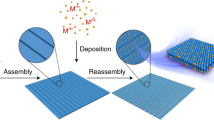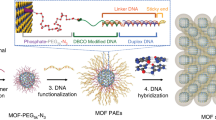Abstract
The use of dendrimer templates to make metal-based nanoparticles of controlled size has attracted much interest. These highly branched macromolecules have well-defined structures that enable them to bind metal ions to generate precursors that can be converted into nanoparticles. We describe the sub-nanometre size control of both anatase and rutile forms of TiO2 particles with phenylazomethine dendrimers, leading to samples with very narrow size distributions. Such fine tuning is possible because both the number and location of metal ions can be precisely controlled in these templates. Quantum size effects are observed in the particles, and the energy gap between the conduction and valence bands exhibits a blueshift with decreasing particle size and is dependent on the crystal form of the material. The dependency of the bandgap energy on these factors is explained using a semi-empirical effective mass approximation.
This is a preview of subscription content, access via your institution
Access options
Subscribe to this journal
Receive 12 print issues and online access
$259.00 per year
only $21.58 per issue
Buy this article
- Purchase on Springer Link
- Instant access to full article PDF
Prices may be subject to local taxes which are calculated during checkout





Similar content being viewed by others
References
Varnavski, O., Ispasoiu, R. G., Balogh, L., Tomalia, D. & Goodson III, T. Ultrafast time-resolved photoluminescence from novel metal–dendrimer nanocomposites. J. Chem. Phys. 114, 1962–1695 (2001).
Scott, R. W. J., Wilson, O. M., & Crooks, R. M. Synthesis, characterization, and applications of dendrimer-encapsulated nanoparticles. J. Phys. Chem. B 109, 692–704 (2005).
Scott, R. W. J., Ye, H., Henriquez, R. R. & Crooks, R. M. Synthesis, characterization, and stability of dendrimer-encapsulated palladium nanoparticles. Chem. Mater. 15, 3873–3878 (2003).
Lang, H., May, R. A., Iversen, B. L. & Chandler, B. D. Dendrimer-encapsulated nanoparticle precursors to supported platinum catalysts. J. Am. Chem. Soc. 125, 14832–14836 (2003).
Tomalia, D. A., Naylor, A. M. & Goddard III, W. A. Starburst dendrimers: molecular-level control of size, shape, surface chemistry, topology, and flexibility from atoms to macroscopic matter. Angew. Chem. Int. Edn Engl. 29, 138–175 (1990).
Tomalia, D. A. Birth of a new macromolecular architecture: dendrimers as quantized building blocks for nanoscale synthetic polymer chemistry. Prog. Polym. Sci. 30, 294–324 (2005).
Zhao, M., Sun, L. & Crooks, R. M. Preparation of Cu nanoclusters within dendrimer templates. J. Am. Chem. Soc. 120, 4877–4878 (1998).
Balogh, L. & Tomalia, D. A. Poly(amidoamine) dendrimer-templated nanocomposites. 1. synthesis of zerovalent copper nanoclusters. J. Am. Chem. Soc. 120, 7355–7356 (1998).
Yamamoto, K., Higuchi, M., Shiki, S., Tsuruta, M. & Chiba, H. Stepwise radial complexation of imine groups in phenylazomethine dendrimers. Nature 415, 509–511 (2002).
Yamamoto, K. Dendrimer complexes: Fine control of metal assembly in macromolecules. J. Polym. Sci. A, Polym. Chem. 43, 3719–3727 (2005).
Yong-Gu Kim, Sang-Keun Oh & Crooks, R. M. Preparation and characterization of 1–2 nm dendrimer-encapsulated gold nanoparticles having very narrow size distributions. Chem. Mater. 16, 167–172 (2004).
Whetten, R. L. et al. Nanocrystal gold molecules. Adv. Mater. 8, 428–433 (1996).
Tsunoyama, H., Negishi, Y. & Tsukuda T. Chromatographic isolation of ‘missing’ Au55 clusters protected by alkanethiolates. J. Am. Chem. Soc. 128, 6036–6037 (2006).
Velarde-Ortiz, R. & Larsen, G. A poly(propylene imine) (DAB-Am-64) dendrimer as Cu2+ chelator for the synthesis of copper oxide clusters embedded in sol–gel derived matrixes. Chem. Mater. 14, 858–866 (2002).
Choi, H. C., Kim, W., Wang, D. & Dai, H. Delivery of catalytic metal species onto surfaces with dendrimer carriers for the synthesis of carbon nanotubes with narrow diameter distribution. J. Phys. Chem. B 106, 12361–12365 (2002).
Juttukonda, V. et al. Facile synthesis of tin oxide nanoparticles stabilized by dendritic polymers. J. Am. Chem. Soc. 128, 420–421 (2006).
Fujishima, A. & Honda, K. Electrochemical photolysis of water at a semiconductor electrode. Nature 238, 37–38 (1972).
Wang, R. et al. Reversible switching between superhydrophilicity and superhydrophobicity. Nature 388, 431–432 (1997).
Oregan, B. & Grätzel, M. A low-cost, high-efficiency solar-cell based on dye-sensitized colloidal TiO2 films. Nature 353, 737–740 (1991).
Anpo, M., Shima, T., Kodama, S. & Kubokawa, Y. Photocatalytic hydrogenation of propyne with water on small-particle titania: size quantization effects and reaction intermediates. J. Phys. Chem. 91, 4305–4310 (1987).
Kormann, C., Bahnemann, D. W. & Hoffmann, M. R. Preparation and characterization of quantum-size titanium dioxide. J. Phys. Chem. 92, 5196–5201 (1988).
Monticone, S., Tufeu, R., Kanaev, A. V., Scolan, E. & Sanchez, C. Quantum size effect in TiO2 nanoparticles: does it exist? Appl. Surf. Sci., 162–163, 565–570 (2000).
Serpone, N., Lawless, D. & Khairutdinov, R. Size effects on the photophysical properties of colloidal anatase TiO2 particles: Size quantization versus direct transitions in this indirect semiconductor. J. Phys. Chem. 99, 16646–16654 (1995).
Geobaldo, F. et al. DRS UV-vis and EPR spectroscopy of hydroperoxo and superoxo complexes in titanium silicalite. Catal. Lett. 16, 109–115 (1992).
Marchese, L. et al. Structure–functionality relationships of grafted Ti-MCM41 silicas. Spectroscopic and catalytic studies. Phys. Chem. Chem. Phys. 1, 585–592 (1999).
Hu, Y. et al. Characterization of the local structures of Ti-MCM-41 and their photocatalytic reactivity for the decomposition of NO into N2 and O2 . J. Phys. Chem. B 110, 1680–1685 (2006).
Rao, C. N. R., Müller, A. & Cheetham, A. K. The Chemistry of Nanomaterials: Synthesis, Properties and Applications Ch. 11 (Wiley-VCH Verlag GmbH, Weinheim, 2004).
Nosaka, Y. Finite depth spherical well model for excited states of ultrasmall semiconductor particles. An application. J. Phys. Chem. 95, 5054–5058 (1991).
Brus, L. E. Electronic wave functions in semiconductor clusters: experiment and theory. J. Phys. Chem. 90, 2555–2560 (1986).
Monticone, S., Tufeu, R. & Kanaev, A. V. Complex nature of the UV and visible fluorescence of colloidal ZnO nanoparticles. J. Phys. Chem. B 102, 2854–2862 (1998).
Vossmeyer, T. et al. CdS nanoclusters: synthesis, characterization, size dependent oscillator strength, temperature shift of the excitonic transition energy, and reversible absorbance shift. J. Phys. Chem. 98, 7665–7673 (1994).
Malik, M. A., O'Brien, P., Norager, S. & Smith, J. Gallium arsenide nanoparticles: synthesis and characterization. J. Mater. Chem. 13, 2591–2595 (2003).
Zhu, K., Shi, J. & Zhang, L. Preparation and optical absorption of InSb microcrystallites embedded in SiO2 thin films. Solid State Commun. 107, 79–84 (1998).
Shen, Q. et al. Photoexcited hole dynamics in TiO2 nanocrystalline films characterized using a lens-free heterodyne detection transient grating technique. Chem. Phys. Lett. 419, 464–468 (2006).
Kavan, L., Grätzel, M., Gilbert, S. E., Klemenz, C. & Scheel, H. J. Electrochemical and photoelectrochemical investigation of single-crystal anatase. J. Am. Chem. Soc. 118, 6716–6723 (1996).
Serpone, N., Bird, P. H., Somogyvari, A. & Bickley, D. G. Five-coordinate titanium(IV) complexes. Infrared spectral studies on X3Ti(diketonato) and XY2Ti(diketonato) complexes and the crystal and molecular structure of di-μ-chloro-tetrachloro-bis(2,4-pentanedionato)dititanium(IV). Inorg. Chem. 16, 2381–2386 (1977).
Satoh, N., Nakashima, T. & Yamamoto, K. Metal-assembling dendrimers with a triarylamine core and their application to a dye-sensitized solar cell. J. Am. Chem. Soc. 127, 13030–13038 (2005).
Nakajima, R., Tsuruta, M., Higuchi, M. & Yamamoto, K. Fine control of the release and encapsulation of Fe ions in dendrimers through ferritin-like redox switching. J. Am. Chem. Soc. 126, 1630–1631 (2004).
Satoh, N. et al. Formation of nano-dots of phenylazomethine dendrimers with Rhodamine 6G on mica. Polym. Adv. Technol. 15, 159–163 (2004).
Yamamoto, K. et al. Novel functional groups with fine-controlled metal assembling function. Bull. Chem. Soc. Jpn 78, 349–355 (2005).
Yan, M., Chen, F., Zhang, J. & Anpo, M. Preparation of controllable crystalline titania and study on the photocatalytic properties. J. Phys. Chem. B 109, 8673–8678 (2005).
Kanazawa, H., Higuchi, M. & Yamamoto, K. Synthesis and chemical degradation of thermostable polyamide with imine bond for chemical recycling. Macromolecules 39, 138–144 (2006).
Tang, J. et al. An organometallic synthesis of TiO2 nanoparticles. Nano Lett. 5, 543–548 (2005).
Takahashi, H., Fujita, K. & Ohno, H. Direct visible spectral analysis of solid samples by optical waveguide spectroscopy due to adsorbed sample molecules after sublimation. Chem. Lett. 36, 116–117 (2007).
Tauc, J. Absorption edge and internal electric fields in amorphous semiconductors. Mater. Res. Bull. 5, 721–729 (1970).
Tauc, J., Grigorovici, R. & Vancu. A. Optical properties and electronic structure of amorphous germanium. Phys. Stat. Sol. 15, 627–637 (1966).
Anpo, M. et al. Photocatalysis over binary metal oxides. Enhancement of the photocatalytic activity of titanium dioxide in titanium–silicon oxides. J. Phys. Chem. 90, 1633–1636 (1986).
Slinkard, W. E. & DeGroot, P. B. Vanadium–titanium oxide catalysts for oxidation of butene to acetic acid. J. Catal. 68, 423–432 (1981).
Scolan, E. & Sanchez, C. Synthesis and characterization of surface-protected nanocrystalline titania particles. Chem. Mater. 10, 3217–3223 (1998).
Zimmerman, A. M., Doren, D. J. & Lobo, R. F. Electronic and geometric properties of ETS-10: QM/MM studies of cluster models. J. Phys. Chem. B 110, 8959–8964 (2006).
Acknowledgements
We thank Y. Einaga, N. Yoshioka and H. Imai for useful discussions. This work was partially supported by CREST from the Japan Science and Technology Agency, Grants-in-Aid for Scientific Research (No. 19205020) and the 21st Center of Excellence (COE) Program (Keio-LCC) from Ministry of Education, Culture, Sports, Science and Technology (MEXT).
Author information
Authors and Affiliations
Contributions
All authors conceived and designed the experiments. N.S. and K.Y. co-wrote the paper.
Corresponding author
Supplementary information
Supplementary Information
Supplementary information, supplementary figures and supplementary tables (PDF 2969 kb)
Rights and permissions
About this article
Cite this article
Satoh, N., Nakashima, T., Kamikura, K. et al. Quantum size effect in TiO2 nanoparticles prepared by finely controlled metal assembly on dendrimer templates. Nature Nanotech 3, 106–111 (2008). https://doi.org/10.1038/nnano.2008.2
Received:
Accepted:
Published:
Issue Date:
DOI: https://doi.org/10.1038/nnano.2008.2
This article is cited by
-
Rapidly predicting Kohn–Sham total energy using data-centric AI
Scientific Reports (2022)
-
Functionalization of phenylazomethine dendrimers
Polymer Journal (2022)
-
Enhanced photocatalytic degradation of Acid Blue dye using CdS/TiO2 nanocomposite
Scientific Reports (2022)
-
Electrochemical Measurement of Bismuth Clusters in Dendrimer Through Transformation from Atomicity Controlled Complexes
Journal of Inorganic and Organometallic Polymers and Materials (2020)
-
Revisiting the optical bandgap of semiconductors and the proposal of a unified methodology to its determination
Scientific Reports (2019)



